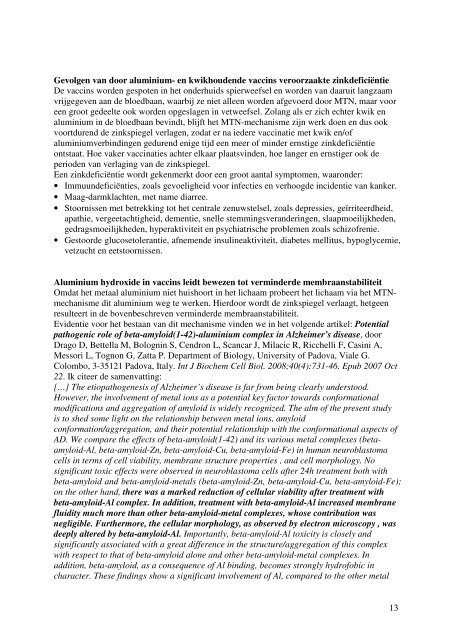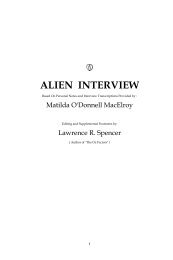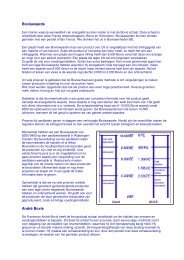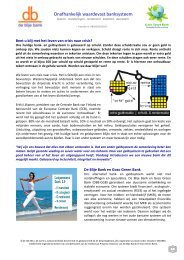De verborgen gevaren van vaccinaties - WantToKnow.nl
De verborgen gevaren van vaccinaties - WantToKnow.nl
De verborgen gevaren van vaccinaties - WantToKnow.nl
Create successful ePaper yourself
Turn your PDF publications into a flip-book with our unique Google optimized e-Paper software.
Gevolgen <strong>van</strong> door aluminium- en kwikhoudende vaccins veroorzaakte zinkdeficiëntie<br />
<strong>De</strong> vaccins worden gespoten in het onderhuids spierweefsel en worden <strong>van</strong> daaruit langzaam<br />
vrijgegeven aan de bloedbaan, waarbij ze niet alleen worden afgevoerd door MTN, maar voor<br />
een groot gedeelte ook worden opgeslagen in vetweefsel. Zolang als er zich echter kwik en<br />
aluminium in de bloedbaan bevindt, blijft het MTN-mechanisme zijn werk doen en dus ook<br />
voortdurend de zinkspiegel verlagen, zodat er na iedere vaccinatie met kwik en/of<br />
aluminiumverbindingen gedurend enige tijd een meer of minder ernstige zinkdeficiëntie<br />
ontstaat. Hoe vaker <strong>vaccinaties</strong> achter elkaar plaatsvinden, hoe langer en ernstiger ook de<br />
perioden <strong>van</strong> verlaging <strong>van</strong> de zinkspiegel.<br />
Een zinkdeficiëntie wordt gekenmerkt door een groot aantal symptomen, waaronder:<br />
• Immuundeficiënties, zoals gevoeligheid voor infecties en verhoogde incidentie <strong>van</strong> kanker.<br />
• Maag-darmklachten, met name diarree.<br />
• Stoornissen met betrekking tot het centrale zenuwstelsel, zoals depressies, geïrriteerdheid,<br />
apathie, vergeetachtigheid, dementie, snelle stemmingsveranderingen, slaapmoeilijkheden,<br />
gedragsmoeilijkheden, hyperaktiviteit en psychiatrische problemen zoals schizofrenie.<br />
• Gestoorde glucosetolerantie, afnemende insulineaktiviteit, diabetes mellitus, hypoglycemie,<br />
vetzucht en eetstoornissen.<br />
Aluminium hydroxide in vaccins leidt bewezen tot verminderde membraanstabiliteit<br />
Omdat het metaal aluminium niet huishoort in het lichaam probeert het lichaam via het MTNmechanisme<br />
dit aluminium weg te werken. Hierdoor wordt de zinkspiegel verlaagt, hetgeen<br />
resulteert in de bovenbeschreven verminderde membraanstabiliteit.<br />
Evidentie voor het bestaan <strong>van</strong> dit mechanisme vinden we in het volgende artikel: Potential<br />
pathogenic role of beta-amyloid(1-42)-aluminium complex in Alzheimer’s disease, door<br />
Drago D, Bettella M, Bolognin S, Cendron L, Scancar J, Milacic R, Ricchelli F, Casini A,<br />
Messori L, Tognon G, Zatta P. <strong>De</strong>partment of Biology, University of Padova, Viale G.<br />
Colombo, 3-35121 Padova, Italy. Int J Biochem Cell Biol. 2008;40(4):731-46. Epub 2007 Oct<br />
22. Ik citeer de samenvatting:<br />
[…] The etiopathogenesis of Alzheimer’s disease is far from being clearly understood.<br />
However, the involvement of metal ions as a potential key factor towards conformational<br />
modifications and aggregation of amyloid is widely recognized. The alm of the present study<br />
is to shed some light on the relationship between metal ions, amyloid<br />
conformation/aggregation, and their potential relationship with the conformational aspects of<br />
AD. We compare the effects of beta-amyloid(1-42) and its various metal complexes (betaamyloid-Al,<br />
beta-amyloid-Zn, beta-amyloid-Cu, beta-amyloid-Fe) in human neuroblastoma<br />
cells in terms of cell viability, membrane structure properties , and cell morphology. No<br />
significant toxic effects were observed in neuroblastoma cells after 24h treatment both with<br />
beta-amyloid and beta-amyloid-metals (beta-amyloid-Zn, beta-amyloid-Cu, beta-amyloid-Fe);<br />
on the other hand, there was a marked reduction of cellular viability after treatment with<br />
beta-amyloid-Al complex. In addition, treatment with beta-amyloid-Al increased membrane<br />
fluidity much more than other beta-amyloid-metal complexes, whose contribution was<br />
negligible. Furthermore, the cellular morphology, as observed by electron microscopy , was<br />
deeply altered by beta-amyloid-Al. Importantly, beta-amyloid-Al toxicity is closely and<br />
significantly associated with a great difference in the structure/aggregation of this complex<br />
with respect to that of beta-amyloid alone and other beta-amyloid-metal complexes. In<br />
addition, beta-amyloid, as a consequence of Al binding, becomes strongly hydrofobic in<br />
character. These findings show a significant involvement of Al, compared to the other metal<br />
13







